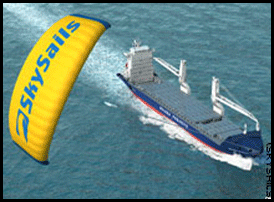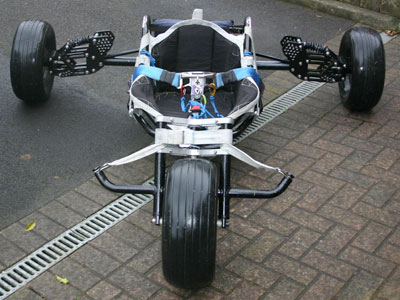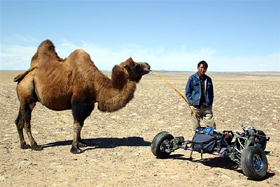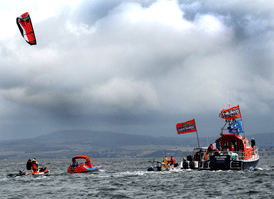Sky Sails: Kite Traction Support for Fuel Efficiency
The SkySails company of Germany will begin sea trials of it's large 160 square metre kite on an ocean going freighter early in 2007. Designed to provide a kite traction assist to the regular diesel engines of the MV Beluga, the large sail is expected to reduce fuel costs by 15 to 20% by using wind power.
Stephan Wrage, inventor and founder of SkySails, reported in Daily Tech, an Inernet news site about the applications of technology, that "I got the idea on a sail boat a few years ago. I love flying kites and found sailing rather slow. I thought the enormous power in kites could somehow be utilized."
Beluga Shipping, working with Wrage and SkySails, will have one ship outfitted and operational early in 2007. The SkySail will be attached to a mast at the front of the ship and will be utilized whenever wind conditions permit. Unlike a sail on a sailboat, traction kites cannot 'tack' with the wind in the same manner. Thus there may be some wind conditions that do not permit deployment of the sail for a traction boost.
As reported in Daily Tech,
"Beluga Shipping is a believer in the technology and is currently having its "MV Beluga SkySails" vessel outfitted with a sail and a computer-controlled central steerage unit. The ship will make its maiden voyage early next year. Beluga Shipping CEO Neils Stolberg estimates the SkySail will drop his company's $7,500 daily fuel bill to $6,000.
"You've got to look at new ideas to cope with developments in oil prices," said Stolberg. "When energy prices double in such a short time, you've got to innovate. We won't be able to switch the engines off. But we're confident we can reduce fuel usage -- and cut emissions."
Sky Sails: Mighty Kite Traction for Large Ships
Kite traction is not a new concept. Instances of using kites to pull water craft and land vehicles are well recorded in the time line of kite history.
Oral histories tell of people of the Pacific islands using kite-like traction sails long before written records of their use were available. In England, George Pocock used a series of steerable kites to pull his "Char Volant" along roads to record speeds over long distances in 1826.
Recent innovations by New Zealand kite designer Peter Lynn have helped to power sleds across ice in Greenland and pull people on small catamarans, known as "Kite-Cats" on a regular basis.
In July and August of 2006 Anne Quemere of France completed the first solo crossing of the Atlantic Ocean in a kite powered boat. It is a remarkable story and an amazing demonstration of the power and versatility of kite powered sailing craft.
 Now, KiteShip a privately held California corporation based in Martinez, CA, with facilities in Palo Alto, CA and Adelanto, CA., is proposing to use massive kites in a commercial manner to support the movement of large ships and reduce the consumption of fossil fuels. The company's mission statement states:
Now, KiteShip a privately held California corporation based in Martinez, CA, with facilities in Palo Alto, CA and Adelanto, CA., is proposing to use massive kites in a commercial manner to support the movement of large ships and reduce the consumption of fossil fuels. The company's mission statement states:
"KiteShip develops and markets Very Large Free Flying Sails (VLFFS) and control systems, technology and techniques for launching, controlling and recovering same aboard boats, ships, industrial and aerospace applications. Such craft may include pleasure and racing yachts, small and large commercial vessel builds and refits, life and vessel saving devices, research and commercial vessels and aerospace / industrial applications both inshore and at sea."
In October of 2006, KiteShip was selected winner of the Transportation Category of the California Clean Tech Open with their very large traction kites, which reduce ship owners' crippling fuel costs by up to 25 percent, and vastly reduce emissions of greenhouse gases and pollutants. KiteShip was featured in an article in the May 2006 issue of Popular Science magazine.
Currently, all KiteShip applications have been targeted at the ocean going sail boat market. Planning is now underway to assist commercial maritime transit with their Very Large Free Flying Sails. The focus of KiteShip will be on reducing the use of fossil fuels, reducing ship operating costs, and increasing ocean crossing time.
 SkySails, a German company, is working toward the same goal of kite assisted transportation on the high seas. The SkySails web site claims that:
SkySails, a German company, is working toward the same goal of kite assisted transportation on the high seas. The SkySails web site claims that:
"By using the SkySails-System, a ship‘s fuel costs can be reduced by 10- 35% on annual average, depending on wind conditions. Under optimal wind conditions, fuel consumption can temporarily be reduced by up to 50%. Even on a small, 87 metre cargo ship, savings of up to 280,000 euros can be made annually.
In 2007 the first SkySails-Systems with towing-kite areas of up to 320m² for cargo vessels will be available. In 2007 series production of the SkySails systems for super yachts, in 2008 series production for cargo vessels will start."
Clearly, kite traction has come a long way from its humble beginnings pulling the small ocean canoes of Pacific Islanders.
The Time it Took! A Timeline of Kite History
 Time, it has been said, marches resolutely on and leaves a record of what has gone before if we are careful to observe.
Time, it has been said, marches resolutely on and leaves a record of what has gone before if we are careful to observe.
There are so many historical events over the course of time. The most recent events and happenings are well recorded and documented but can still be open to varying interpretation. The more distant events are harder to trace and often do not have many validating or corroborating sources of information. So it is with the history of the earth, of mankind, of cultures and nations, and of devices and inventions.
Several years ago, sixteen to be exact, I set out to puzzle out for myself a credible timeline of kite history. The purpose in my mind was simple: order the events and chronicle the people who had contributed to the development of the kite and used it in innovative and interesting ways. A simple task, I was sure.
Not so! Here I am sixteen years later publishing for the first time my efforts at recording a brief, and hopefully useful, chronology of the kite. I have postponed the publication of any of the timelines on this web site many times. I did this because I continued to find conflicting evidence about the order and timing of events. Revision, checking more sources, update and more revision became an ongoing state of affairs.
I believe that the timelines published here today are very accurate, but they are not infallible. As with any historical effort covering a broad scope there is room for error even with the most thorough checking of facts having been carried out.
I know that these timelines will need to be revised again and again as new information is brought forward and as conflicting evidence challenges details or dates.
I have published the timelines at this juncture because I believe in their accuracy. I know that the scrutiny of kiters and people with a deep interest in things historical will undoubtedly lead to challenges and the correction of possible errors. I welcome your input, your questions, your dialogue and your sharing of factual evidence. Only through such cooperative effort can a properly validated timeline of kite history be available for use by students in schools and for reference by kiters who would like to know more about the development of this amazing device, the kite.
To begin your journey through time and experience the chronicle of the kite, I invite you to visit the Best-Breezes Timeline of Kite History.
Please contact me if you wish more information, have questions or can suggest some sources or evidence to improve the timeline.
Bob White - Hifliercanada - October 30, 2006
_______________________________________
Captain Jean-Luc Picard:
"Time is a companion that goes with us on a journey. It reminds us to cherish each moment, because it will never come again. What we leave behind is not as important as how we have lived."
played by Patrick Stewart, from the film "Star Trek: Generations"
Anne Quemere Completes Atlantic Crossing Powered by Kite
On August 14, 2006 Anne Quemere successfully completed the crossing of the Atlantic Ocean from New York to Brittany in a special boat powered only by a kite.
Anne's historic and epic crossing was noted as follows in her daily journal on her web site:
Launched in New-York (USA) on June 18th, 2006 the Oceankite, piloted solo by Anne Quéméré, crossed the “Ile de Ouessant” this day, after some 55 days of a 3450 (total) nautical mile Atlantic Ocean crossing.
At dawn, weather conditions became extremely difficult, (North-East wind with 30 knot squalls, accompanied by heavy seas and strong currents close to the “Ile de Ouessant”), increased the safety risks. The team that met Anne took the decision to tow the Oceankite because of the heavy sea-going cargo ships.
The crossing thus ended on August 13th, 2006 at 6. 45 PM at 5°50 W. latitude.
The Connétable 2006 Challenge was a true achievement in all fields: the navigator Anne Quéméré completed this solo crossing with a new sailing concept; on the physical plain: the piloting required excellent physical conditioning as well as requiring constant attention. From a technical aspect, the Connétable prototype, conceived and produced by architect Marc Ginisty showed its true capabilities. An extremely difficult weather pattern, accompanied by long periods of calm weather during these 55 days, slowed the crossing of the Connétable.
After crossing the Finish line Anne admitted that this challenge had been more difficult than the previous two, on the Southern Atlantic in 2003 and on the Northern Atlantic in 2004, where she had paddled the complete distance.
The dramatic story of Anne's complete voyage can be found on her web site. Her accomplishment is a major milestone for kite traction and a personal triumph of determination and careful planning by both Anne and her team. Congratulations Anne!
For previous entries on this story see:
Brian Cunningham's Crossing of Gobi Desert by Kite Buggy Honoured by Guinness Record
 Professor Brian Cunningham of Bolton England has been awarded the Guinness Book of Records award for travelling the longest distance in a kite powered buggy: 1,000 kilometres (600 miles) across land by kite power in September 2004.
Professor Brian Cunningham of Bolton England has been awarded the Guinness Book of Records award for travelling the longest distance in a kite powered buggy: 1,000 kilometres (600 miles) across land by kite power in September 2004.
The original crossing of the Gobi Desert was reported by The Manchester News and posted in Best-Breezes in a Sept. 28, 2004 posting here.
During his records setting journey, Cunningham was accompanied by his wife, Christine, who acted as first aider and photographer, and two other expedition members, Kieron Bradley, aged 32, and Peter Ash, aged 36, both from Norfolk.
Cunningham is no stranger to adventure. In 2002, he attempted to cross the Antarctic in a kite buggy but failed when he hit one of the most windless periods on record. At present he does not have any plans for additional kite traction adventures.
The buggy used by Cunningham was specially designed for the long distance ride and for the conditions of the Gobi Desert. It was named the "Parastorm Gobi Buggy". The buggy carried Cunningham at speeds up to 50 mph and was equipped with independent rear suspension, adjustable shocks, ride-height adjustment, wheel camber adjustment, full underseat belly pan, 18” four-ply wheels all round, quick-release off-line flying system, oversize splashguard, and a special rear axle brace.







